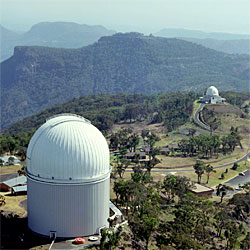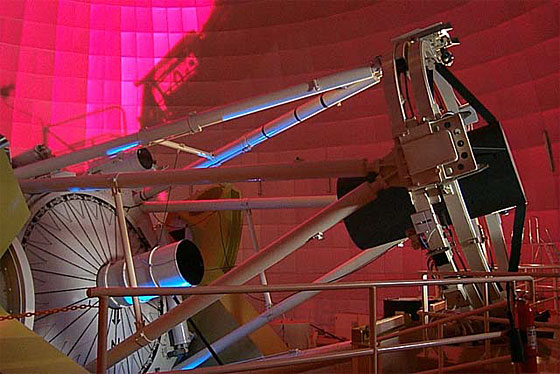[/caption]
While the Anglo-Australian Telescope is far from being the world’s largest, or even located in the world’s best observing site, it’s still the world’s most productive in terms of astronomy research. According to recently released productivity ratings, the number of scientific papers resulting from observations made with the AAOmega fibre-fed optical spectrograph, SPIRAL Integral Field Unit, IRIS2, University College London Echelle Spectrograph (UCLES), or Ultra High Resolution Facility (UHRF) made the AAT the number one ranked 4-metre-class telescope in the world for more than two years between 2001 and 2003. But what’s going on today is even more important…
When we think of research telescopes, some of the world’s top rated are the Hubble Space Telescope (located in Earth orbit), Keck (more than twice the AAT’s size) in Hawaii, the Very Large Telescope (VLT, which comprises four telescopes twice the size of the AAT) in Chile, the Sloan Digital Sky Survey and the 2MASS telescope. So where does that leave the humble Anglo-Australian? Try number five. “The AAT has a remarkable track record of scientific productivity and impact,” says Prof. Matthew Colless, Director of the Anglo-Australian Observatory. “This is an extraordinary achievement.”
 When the Anglo-Australian Observatory opened for business in the early 1970’s, the 4 meter telescope was the standard by which all others were judged. Since that time, research telescope aperture has more than doubled and while the AAT can’t compete in some respects, it has advantages that give it an edge for research. While it isn’t Mauna Kea, Australia still offers up some of the best skies to study our Galaxy and other nearby galaxies and the ability to undertake long-term observations and programs that just won’t work with other observatories. Add to that some very unique instrumentation such as Echidna – a fibre positioner for FMOS, UKidna – A multi-fibre positioner for the UKST, OZPOZ – a fibre positioner for ESO and part of FLAMES, DAZLE – The Dark Age z (redshift) Lyman-alpha Explorer, MOMFOS – Multi-Object Multi-Fibre Optical Spectrograph, ODC – Optical Detector Controllers and AAOmega – next generation optical spectrograph for the AAT and you have a recipe for research. This explains why demand for the telescope remains strong, with 2.5 times as many applications for telescope time as can actually be handled. “The AAO believes that the AAT can maintain this high level of productivity and impact for another decade.” says Prof. Colless.
When the Anglo-Australian Observatory opened for business in the early 1970’s, the 4 meter telescope was the standard by which all others were judged. Since that time, research telescope aperture has more than doubled and while the AAT can’t compete in some respects, it has advantages that give it an edge for research. While it isn’t Mauna Kea, Australia still offers up some of the best skies to study our Galaxy and other nearby galaxies and the ability to undertake long-term observations and programs that just won’t work with other observatories. Add to that some very unique instrumentation such as Echidna – a fibre positioner for FMOS, UKidna – A multi-fibre positioner for the UKST, OZPOZ – a fibre positioner for ESO and part of FLAMES, DAZLE – The Dark Age z (redshift) Lyman-alpha Explorer, MOMFOS – Multi-Object Multi-Fibre Optical Spectrograph, ODC – Optical Detector Controllers and AAOmega – next generation optical spectrograph for the AAT and you have a recipe for research. This explains why demand for the telescope remains strong, with 2.5 times as many applications for telescope time as can actually be handled. “The AAO believes that the AAT can maintain this high level of productivity and impact for another decade.” says Prof. Colless.
Over a period of time, the the AAO has produced some of the most inspiring astronomy images ever seen – those taken by David Malin. These are the most extraordinary wide-field astrophotographs made with professional telescopes anywhere and every effort has been made to capture the true colours of distant stars, galaxies and nebulae using innovative photographic techniques and CCD detectors. The images have detailed captions and the full NGC 2000.0 catalogue entry. Galaxy images also carry NASA/IPAC Extragalactic Database (NED) data links. They are a standard of astronomers everywhere. But, progress hasn’t stopped. The AAT’s prime focus has recently been upgraded to accommodate a new generation of highly sensitive CCD detectors. The first colour images made with the new facility are now available, currently only in digital form. Most of the photographic images have recently been digitally re-mastered from the original 3-colour separations. This has allowed the AAO to create new, high resolution versions of many existing images and some new pictures that could not be made photographically.
Just this year a “uniquely ambitious, far-sighted†project won an Australian and UK astronomy team the first Group Achievement Award from the UK’s Royal Astronomical Society. Led by Professor Matthew Colless (Anglo-Australian Observatory) in Australia and Professor John Peacock (University of Edinburgh) in the UK, the thirty-three-member team spent ten years mapping the distribution in space of 220,000 galaxies using the 3.9-m Anglo-Australian Telescope (AAT) in New South Wales — a project called the 2-degree Field Galaxy Redshift Survey (2dFGRS). “The scale of this project made it ground-breaking,†said Matthew Colless. “For the first time we were able to map the positions of a huge number of galaxies and see the subtle effects that reveal the different types of matter in the universe.â€
What was needed was for the area of sky surveyed to be much bigger than, rather than the same size as, the “walls†and “strings†of galaxies being detected. Almost ten times larger than any previous survey, the 2dFGRS was the first study to meet this crucial condition. The survey measured patterns in the distribution of galaxies, on scales from 100 million to 1 billion light-years. Two wedge-shaped pieces of sky were surveyed, so when the galaxies within them were mapped out, the result looked like a bow-tie cut from a sponge: a network of voids and dense regions. The size of the 2dF Galaxy Redshift Survey was made possible only by technological advances developed at the Anglo-Australian Observatory (AAO). The 2dF spectrograph used robotic technology to place optical fibres onto the telescope’s focal plane, where each fibre could collect the light from a single galaxy. By using up to 400 optical fibres, this system allowed the light from up to 400 galaxies to be captured simultaneously.
And the AAT is ensuring that it doesn’t fall behind the times with future technological advancement either….
“We are currently investing $4 million in refurbishing the telescope to ensure that it can operate reliably and efficiently for another ten years, and more than $6 million in a major new instrument, the 400-fibre HERMES high-resolution Spectrograph,” says Prof. Colless. “The primary science drivers for HERMES are ‘Galactic archaeology’ surveys to uncover the formation history of the Milky Way,’ he adds. ‘Extragalactic surveys using the AAOmega instrument and galactic surveys using HERMES will be the flagship science carried out on the AAT over the next 5-10 years. AAOmega and HERMES, and other upgrades to existing instruments, will provide astronomers with powerful tools that will enable them to do competitive, high-impact research using the AAT throughout the coming decade.”
Original Source: SpaceInfo.com


Yiieeew! Up the Aussies!
It continues to amaze me how this telescope, quite humble in size, doggedly remains at the absolute bleeding edge of astronomical research. This is due in large part to the inspired and innovative instrumentation that the team at AAT continues to develop.
Congrats on many years of fine astronomical research AAT, and here’s to many more!
I think the AAO is one of the greatest ever observatories, it has done amazing research and David Malin has done some of the greatest pictures of the universe that only now are being bettered by amateurs! In fact if it weren’t for his iconic Horsehead widefield, I might not even have gotten interested in astronomy!